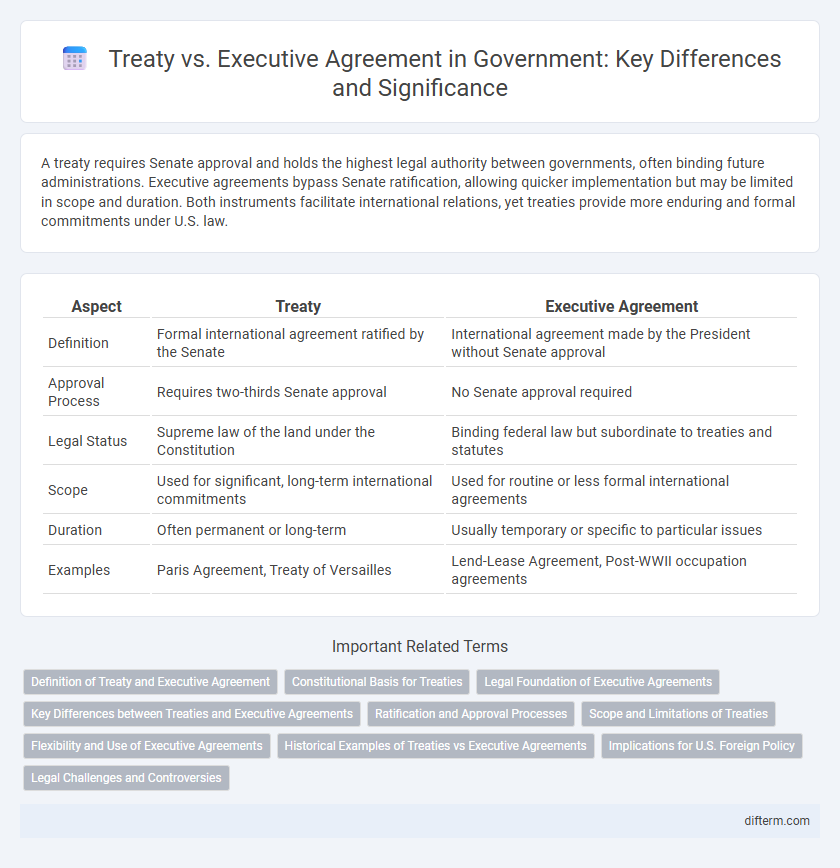A treaty requires Senate approval and holds the highest legal authority between governments, often binding future administrations. Executive agreements bypass Senate ratification, allowing quicker implementation but may be limited in scope and duration. Both instruments facilitate international relations, yet treaties provide more enduring and formal commitments under U.S. law.
Table of Comparison
| Aspect | Treaty | Executive Agreement |
|---|---|---|
| Definition | Formal international agreement ratified by the Senate | International agreement made by the President without Senate approval |
| Approval Process | Requires two-thirds Senate approval | No Senate approval required |
| Legal Status | Supreme law of the land under the Constitution | Binding federal law but subordinate to treaties and statutes |
| Scope | Used for significant, long-term international commitments | Used for routine or less formal international agreements |
| Duration | Often permanent or long-term | Usually temporary or specific to particular issues |
| Examples | Paris Agreement, Treaty of Versailles | Lend-Lease Agreement, Post-WWII occupation agreements |
Definition of Treaty and Executive Agreement
A treaty is a formal, legally binding agreement between two or more sovereign states that requires ratification by the legislative branch, typically the Senate in the United States. An executive agreement, by contrast, is an international agreement made by the executive branch without requiring Senate approval, often used for routine or less critical matters. Treaties have higher legal standing and permanence, whereas executive agreements offer flexibility and speed in diplomatic relations.
Constitutional Basis for Treaties
The constitutional basis for treaties is established in Article II, Section 2 of the U.S. Constitution, granting the President the power to make treaties with the advice and consent of two-thirds of the Senate. Treaties become binding international agreements that hold the force of law upon ratification. In contrast, executive agreements do not require Senate approval and are derived from the President's inherent constitutional powers or existing statutes, making them less formal but important tools for foreign relations.
Legal Foundation of Executive Agreements
Executive agreements derive their legal foundation primarily from the President's constitutional authority to conduct foreign affairs and the power granted by prior treaties or congressional statutes. Unlike treaties, which require Senate ratification under Article II, Section 2, of the U.S. Constitution, executive agreements can be enacted solely by the executive branch, streamlining international commitments. This distinction enables the President to respond swiftly to international issues without the lengthy approval process, although such agreements remain subject to judicial review to ensure compliance with existing laws and constitutional limits.
Key Differences between Treaties and Executive Agreements
Treaties require Senate approval by a two-thirds majority, while executive agreements do not need Senate consent and are made solely by the executive branch. Treaties have a higher legal status under the Constitution and are binding on future administrations, whereas executive agreements are often more flexible and can be modified or revoked by subsequent presidents. Furthermore, treaties generally address significant or long-term international commitments, whereas executive agreements typically handle routine or administrative diplomatic matters.
Ratification and Approval Processes
Treaties require Senate ratification with a two-thirds majority vote, ensuring legislative oversight and formal approval before implementation. Executive agreements bypass Senate approval, allowing the President to quickly establish binding international arrangements without congressional consent. This distinction streamlines foreign policy actions but limits legislative input in executive agreements compared to treaties.
Scope and Limitations of Treaties
Treaties are formal, legally binding agreements between sovereign states or international organizations, requiring Senate ratification in the United States, which ensures broad scope and durability in international law. Executive agreements, by contrast, are made by the President without Senate approval and typically cover narrower, more specific issues with limited international impact. The scope of treaties includes comprehensive obligations and rights under international law, while their limitations involve the requirement for legislative consent and the potential for complicated, lengthy negotiation processes.
Flexibility and Use of Executive Agreements
Executive agreements offer greater flexibility than treaties by bypassing the Senate approval process, allowing the President to swiftly address international matters. These agreements are commonly used for routine or technical issues where formal treaties would be impractical. While treaties require a two-thirds Senate majority for ratification, executive agreements enable more agile diplomatic actions tailored to immediate foreign policy needs.
Historical Examples of Treaties vs Executive Agreements
The Treaty of Versailles (1919) exemplifies a formal, Senate-ratified treaty that shaped post-World War I geopolitics, while the 1972 Strategic Arms Limitation Talks (SALT I) agreements highlight executive agreements that bypass Senate approval for swift implementation of arms control measures. The Treaty of Guadalupe Hidalgo (1848) ended the Mexican-American War through a congressional treaty ratification process, contrasting with the 1947 Taft-Hartley Act executive agreement used to address labor disputes without formal Senate consent. Historical precedence shows treaties requiring Senate ratification for binding international commitments, whereas executive agreements offer presidents flexibility in managing foreign policy swiftly.
Implications for U.S. Foreign Policy
Treaties require Senate ratification and carry significant weight in U.S. foreign policy, establishing binding commitments under international law. Executive agreements, made by the President without Senate approval, allow for more flexibility and swift diplomatic action but may lack the long-term stability of treaties. The use of executive agreements can expedite negotiations but may lead to challenges in consistency and congressional oversight in foreign policy decisions.
Legal Challenges and Controversies
Treaties, negotiated and ratified by the Senate, face rigorous legal scrutiny and potential constitutional challenges, ensuring a higher threshold for international commitments. Executive agreements, made solely by the President without Senate approval, often provoke legal controversies regarding their legitimacy and scope under the Constitution. Courts frequently examine the balance of executive power and congressional authority, highlighting ongoing debates over the separation of powers in treaty-making processes.
treaty vs executive agreement Infographic

 difterm.com
difterm.com